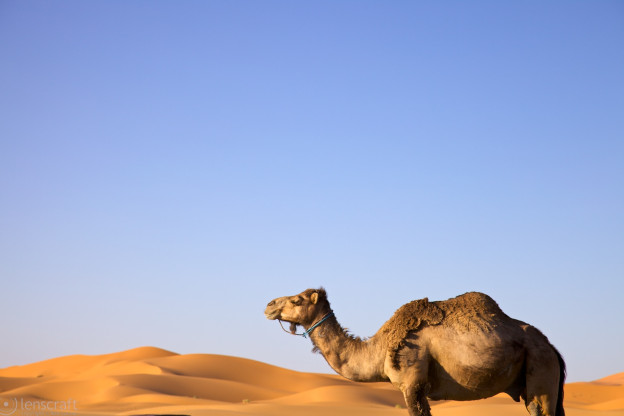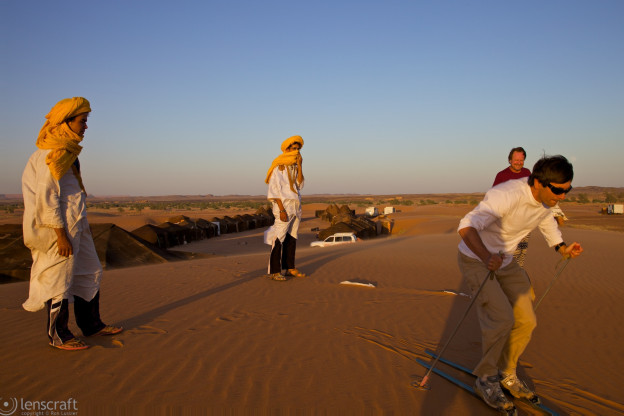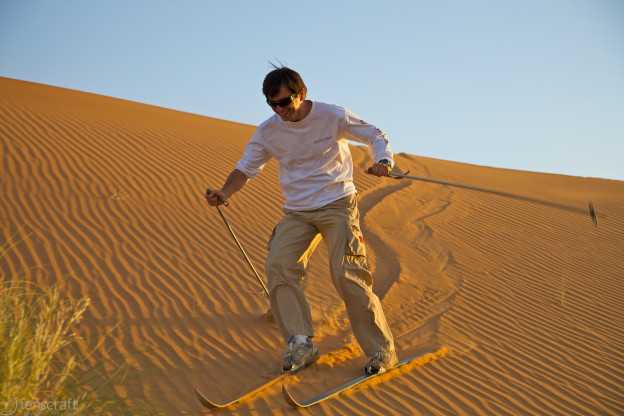(It felt good to be out of the rain.)
(Parenthetically, I am typing this entire journal entry for the second time. The first time was at a different internet cafe, a much worse one, where their Windows machines kept crashing, and the Internet Explorer 6 browser kept hanging. It hung after I’d typed this entire tale and pressed send. I hate IE6.)
At the base of the Erg Chebbi dunes we meet our camels. The first camel is white and affectionate, the others black and slightly more ill-tempered. They are tied nose-to-tail and laying in the sand in a circle. The sand blows against them in drifts. Occasionally, one of the camels farts.
Each is saddled. The saddle on a camel looks like an upholstered doughnut, draped with blankets. It sits on the hump and basically extends it front and rear. The saddle also has a metal bar that raises from the front of the saddle to a ‘T’. As there are no stirrups, the handlebar is your only way to hold on.
I eye my camel, and it eyes me. I approach, and find that even with the camel laying on the ground, there was no way I can get my leg over. Remember, no stirrups. A small stepladder would be appreciated, but it is not forthcoming.
So, a small jump, a very undignified belly roll, and I am sitting astride my beast, which to its credit only grunts slightly in protest. I am told to hold onto the bar, and I do. It is a good thing, because The Arising is about to begin.
A camel is essentially what resulted when an evil sorcerer bred a shag rug with a loading gantry. It’s much more mechanical contraption than animal, but with a bad attitude and some enormous teeth thrown in.
The Arising goes like this… the camel first unfolds one of its rear leg joints. This props up the beasts tail,. but leaves its neck on the ground. You find yourself hanging on tightly, staring straight down at the camel’s head. The camel, encrossed in its Arising, ignores you.
Then, the front legs unfold, putting the neck far above the creature’s tail. You continue to hang on for dear life, but now you are staring straight up at the sky, and gravity is trying to pull you off the back of the camel.
Lastly, the second set of leg joints unfold, and you come to a level position, roughly eight feet above the ground, riding a hump in the sky. The entire process is like a carnival ride whose goal is to disorient you. The camel swivels it’s snake-like neck enough to see if it managed to dislodge you, and seeing that it has not, it accepts that you’re stuck there, at least for now.
Everyone clings to their bars, a Amazigh (Berber) tribesman leads the camel train out into the dunes. The sand stretches out as far as you can see, in deep orange drifts hundreds of meters high.
On level ground, the camel takes long strides. While the animal is covering lots of ground this way, you sway every which way from your post at the pinacle of the camel’s hump. Every movement side-to-side, every lurch back and forth is amplified. Dan and Sorin each ask me if I am getting seasick. (I am not.)
When climbing a dune, the camel takes smaller steps, with a pause after each as their hooves catch the sand. You, however, are hanging on desparately trying not to slide off the back of the camel.
Descending a dune is even worse. The camel steps down into the sand, and it’s dinner-plate-sized hoof glissades down into the sand a foot or two before finally catching enough sand. Then the process is repeated with the next foot. Eight feet in the air, you are leaning forward at a 45 degree angle as the camel first free-falls forward, then suddenly stops. Then again, and again, until you reach level sand again. You hold onto the metal bars with every ounce of your strength. Two days later, your wrists and forearms will still be hurting.
On level sand, you can shift your weight around, and it’s a good idea. Your butt gets very numb sitting in one position, and your thighs get sore. The Amasigh ride side-sadle, and all of us try it, but we quickly return to a straddle when we see a climb or drop coming.
The sea of sand is stark. There are a few small arid bushes, and there is sand. Unimaginable quantities of sand, extending for miles. The sand is all. It absorbs all sound, so as the camels step steadily forward, we hear nothing except for the occasional fart, which is very loud indeed in the quiet of the desert. When we speak with one another, it feels like we are shouting in church, breaking some sort of holy silence. The wild blows. The sand moves slowly. The camels step forward. The sand absorbs sound, and it also seems to absorb time.
Two hours (or two years, or several seconds) later we droppe down into a valley between dunes. There the Amazigh camp waits for us. The camels were led into a circle, and the Descent begins.
The Descent is like the Arising, except in reverse. I find myself rocked violently back and forth before I’m finally back at ground level. The camel (no name, remember?) looks back at me, it’s large soulful eyes conveying one simple thought… “Get off.”
We are met by an Amazigh boy. He is wearing an elaborate saffron turban and a white flowing robe. He sports buck teeth and french designer eyeglasses. He looks like a particularly fashionable nerd on his way to a college costume party. I am instantly smitten.
He shows us to our tents. There isn’t much to unpack, as we’ve brought only a minimal change of clothing. We gather in the shade of one of the larger tents, simply watching the sand gently blow over the crest of the dune next to us.
A small group of french tourists arrived, not via camel, but in range rovers. They emerged sweating, and we watch them. Dan and I sit side by side in the shadow of the tent, wearing our shesh’s, judging them. We were the true travelers of the Sahara, not these newcomers conveyed by road with air conditioning.
Sorin and Josh join us, and we sit some more. Then Sorin notices, half buried in a drift, a set of skis and some poles. His eyes light up. He stands. “I will ski!” he declares.
He digs out the skis and the poles, and trudges to the top of the nearest dune. The Amazigh tribesmen follow, as do the newly-arrived and sweaty French. The Amazigh look amused, and the French looked judgemental. Sorin stands at the top of the dune looking fearless. Dan and I resolve to photograph this momentous event. In the tent, Joshua naps.
One at a time, Sorin clamps the skis to his sneakers. The skis sit on the knife-edge of the dune ridge like a teeter-totter, sticking out into the air front and back. Sorin looks at the horizon. He looks down. (One tribesmen says something in tamazight, and another nods. Perhaps he said “Fetch the Medevac.” We will never know.) Sorin looks out at the horizon again, then pushes off.
The skis accelerate down the slope gaining speed. Not too much speed, however, as the slope is only 10 feet long. But there is a proof of concept. It is possible to ski down a dune. Joshua is awakened to witness this miracle. (Rather than appreciate the wonder of the moment, he just seems a little grumpy.)
The next hour is spent skiing down higher and higher dunes. Sorin does it, and impresses everyone by managing to turn as he descends. (Not the easiest thing to do in sand.) Even the French stop disapproving for a moment. Dan tries it and makes it smoothly to the bottom. I try and fall on my face within three feet. Joshua slides smoothly down and makes it look easy. An amazigh tribesman gives it a go, clamping the skis to his bare feet. (A gasp of appreciation from the French. Everyone loves the macho.) And then it is dark, and time for apres-ski.
We eat dinner in the big central tent, a typical maroccan meal except for the nice maroccan rosé that we ordered off of the wine list. It goes nicely with the tagine, and even Joshua likes it. Also atypical is the rather large scorpion that skitters across the floor mid-dinner, all chiton and poison before disappearing under a corner of the tent.
The next day we return across the dunes to our car and drive vaguely west along the southern foothills of the High Atlas to the Todra Gorge. There, on the outskirts of the village of Tingir, I type this into a terminal in an internet café. Around me teenagers learn the facts of life from watching Madonna videos on YouTube. Each terminal has a curtain that can be pulled around it for privacy, but I can hear the melody of “Like a Virgin” leaking from the headphones. Teenagers everywhere like their music loud.
Tomorrow we will climb into the High Atlas.









